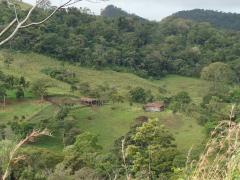Nicaragua Tidbits
We found Nicaragua to be a delightful country. Despite the fact that all any of us remember about it is the war in the 80s and the US involvement in it, Nicaragua is a tranquil, safe, and friendly place. We didn't have to pretend that we weren't Americans... We were received with great friendliness everywhere we went. We found no vestiges of the 1980's socialist agenda, and museums were the only obvious physical relics of the wars.
We had heard various things about safety in Nicaragua, but what we found was a country where nobody seems worried about crime at all (except in Managua, which we didn't visit). Nicaragua is reputedly the safest country in Central America, possi bly including Costa Rica in that tally. Sometimes in Guatemala and Honduras when we would ask about a particular back road we would be warned off: "not enough people there, not enough police, dangerous", in Nicaragua we'd ask and they'd say "oh, yeah, that's great, no problems with delinquency here".
All this and Nicaragua is the most resource-poor country in Latin America, with a per-capita average income for the whole country of just $700 or so. We saw some pretty simple shacks, and there are far more outhouses in rural Nicaragua than there are flush toilets. There may not be any flush toilets in rural Nicaragua. The more remote places may not have many outhouses, although many aid projects have been putting them in by the thousands.
There is an absolutely staggering number of NGOs (non-government aid organizations, or Non-governmental Organizations) working here. In remote villages on dirt roads we'd see signs: "1000 latrines provided by the European Untion", "Road improvement sponsored by Japan", "Environmental mitigation sponsored by World Vision". Every sign about a "project" would carry the logos of the various organizations that sponsored it. Despite all these active projects, there remains enormous need in Nicaragua. They're living on the raw edge economically. We saw projects sponsored by the aid organizations of governments: Japan, France, Spain, the US, and the European Union. And we saw some by religious aid organizations like World Vision and Save the Children. And there were a few little independents like Agua para la Vida that we visited in Rio Blanco, and a significant house-building and community improvement project run by a Rotary Club out of California.
There aren't many people here who speak English, but English is a prestige language, so there are lots and lots of businesses that carry mangled English-type names like "Bar Jonhy's" or an eatery called "Lucy's Delihgt".
Prices in Nicaragua were among the cheapest we've found. We spent $5 to $20 for a hotel, about $30 for a doctor visit, full lab tests,` and 4 kinds of antibiotics and other drugs, $1.50 -$2.50 for a simple meal in a comedor or $3-6 for a meal in a restaurant.
Nicaragua has a real up-and-coming and very unique tourism program. In addition to major development on the Pacific beaches and the classic gringo hangouts in Granada and Leon, there is the delightful, quiet island of Ometepe in the middle of Lake Nicaragua (good tourist services, quiet, plenty of things to do, cheap). But the most fascinating thing they have is called "rural ecotourism". There is a whole book published and available throughout the country on little tiny tourism opportunities where you can visit a poor rural family, spend the night, hike or horseback ride in a nature reserve or get a glimpse of their daily work life, all for $5-$20/day. The directory of opportunities is in Spanish, but would be accessible via any of the many tourist travel agencies in Nicaragua.
Nicaragua probably was a little harder on us health-wise than other places we've been, but we don't know why, of course. Both of us had intestinal issues, and both had a fever to go with it for the first time on the trip. But we were way off the beaten track and found great healthcare to help us out.
Nicaragua: Highly recommended!

